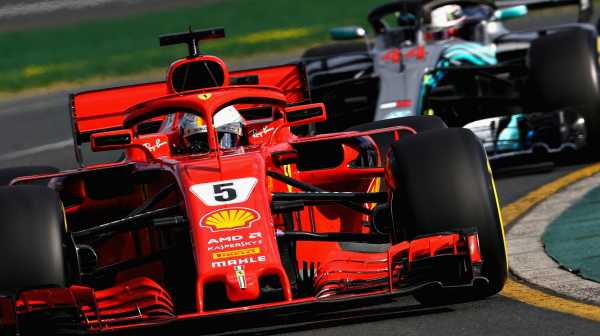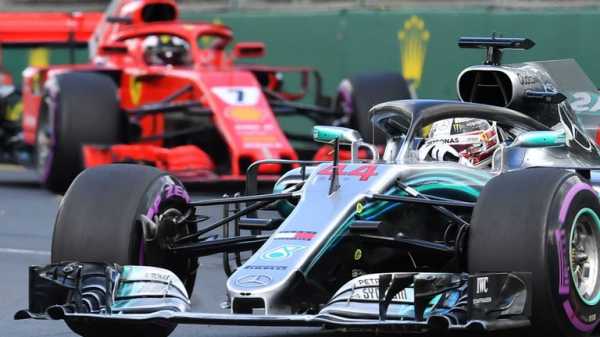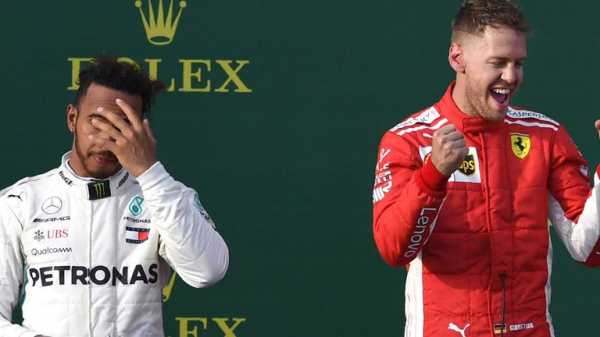
Listen to Lewis Hamilton's radio messages with his Mercedes team after Sebastian Vettel was able to get ahead of him at the Australian GP.
Lewis Hamilton and Mercedes were cruising at the Australian GP, but Sebastian Vettel was the unlikely victor. How did he do it?
After 25 laps of the Australian GP, Lewis Hamilton and Mercedes were in complete control.
Six seconds ahead of closest challenger Kimi Raikkonen with his Ferrari team-mate Sebastian Vettel leading the race but yet to pit, the world champions seemed destined for a comfortable victory.
Oz GP report: Vettel steals win
F1 2018: How to watch with Sky F1
But, despite no obvious mistake from either Hamilton or Mercedes, Vettel won the first race of the 2018 season.
So, how did he do it?

A Virtual Safety Car and the opportunistic Ferrari
On Lap 19, it seemed as if the Scuderia were placing their race-winning eggs in Raikkonen’s basket, pitting the Finn -who was running second behind Hamilton – to put pressure on Mercedes.
Mercedes responded straight away to cover off their rivals, bringing in Hamilton one lap later for the same soft tyres. Not only did this work, but they extended their advantage over Raikkonen from three to five seconds.
So far, so good. But what the Silver Arrows didn’t account for was not one, but two Haas pitstop malfunctions with both Kevin Magnussen and Romain Grosjean retiring from the race and pulling their cars to the side of the track due to loose wheel fittings.
Hamilton explains how he lost time
The second of those retirements saw a Virtual Safety Car deployed – and enabled Ferrari to pounce.
Vettel was around 12 seconds ahead of Hamilton prior to Grosjean’s exit but pit-stops at Melbourne’s Albert Park take around 23 seconds, so in theory the German would have been more than 10 seconds behind Hamilton after pitting in normal conditions.
But the Virtual Safety Car meant Hamilton and the rest of the field had to slow to a set pace, while Vettel could dive into the pits and make up much more ground than he would otherwise be able to manage. The pitlane, in contrast to the track, did not have an additional speed restriction due to the VSC.
The German coming out ahead of Raikkonen was to be expected, but Vettel even emerged from the pits marginally in front of a startled Hamilton.
“What just happened guys?” a confused Hamilton asked his Mercedes team over the radio. “Why didn’t you tell me Vettel was in the pits?
“We thought we were safe, but there’s obviously something wrong,” was the reply.
“Did I do anything wrong? Should I have gone faster?” retorted Hamilton.
A Mercedes computer glitch
But that’s the problem – presuming he was pushing his W09 to the maximum speed under VSC conditions – Hamilton was not allowed go any faster.
Mercedes said they would investigate the theory Hamilton wasn’t driving quickly enough, but as Sky F1’s Ted Kravitz said: “You’d have to imagine he wouldn’t make a mistake like that, he’s quite used to that.”
What seems far more plausible is the admission from Toto Wolff there was a glitch in Mercedes’ timing systems.
“We thought we had about a three-second advantage,” the Mercedes team principal & CEO told Sky F1. “The problem is within our system. The gap that we needed was wrongly calculated.
“The way the algorithm is set up, the way the computer is being programmed, we always had the green light and the gap was enough for us to stay ahead. And then we saw the TV pictures and it wasn’t enough.
“It’s very hard to take because we had the pace.”
Hamilton seemed to suggest in the post-race press conference that he could have done something about it if he was informed about his gap to Vettel and the VSC delta correctly, and Ted agreed.
“Had Hamilton been told that Vettel is going to beat us if there’s a Virtual Safety Car, the data suggests that Hamilton would have been able to get that extra 1.5 seconds that would have meant this would have never happened,” he said.

It was a theory backed up by Wolff, who claimed that while Hamilton was extending his gap to Raikkonen after the first stop, he could have gone even faster as Mercedes were stretching out the tyres to last until the end of the race.
“In hindsight, they should have gone like hell but they didn’t because they thought they got it covered in their algorithm,” added Sky F1’s Martin Brundle.
Hamilton was within DRS range for the remainder of the race and pushed and pushed on older tyres than Vettel, but just could not get past a Ferrari which displayed greater pace than perhaps most imagined.
“Lewis is going to be gutted, and confused,” concluded Brundle.
Comment below to get involved in the debate, but please adhere to our House Rules. If you wish to report any comment, simply click on the down arrow next to the offending comment and click ‘Report’.
Also See:
Sourse: skysports.com






